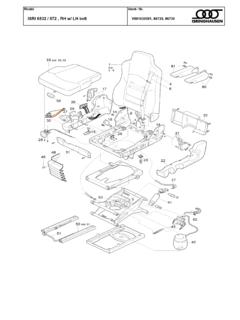Transcription of The Ergonomic Seating Guide - Millers Inc.
1 The ErgonomicSeating GuideHANDBOOKS tatistics and studies reveal that Ergonomic Seating is something all employers should consider for their office staff. That being said,the goal of this handbook is to show you why Ergonomic Seating is so vital for workers and how Haworth provides the solution they You Need This Handbook ..In 2004, approximately million workers received a total of $ billion in workers compensation costs for injuries that occurred on the job (the latest year for which data were available). Additionally, in 2005, the total number of days lost to workers because of injuries occurring on the job totaled 80 million. Off-the-job injuries can potentially affect a company s productivity even more with days lost totaling about 195 With figures like these, the importance of providing a well-designed work environment with appropriate training which could help lessen costs as well as days lost to injuries is obvious. The possibility of sitting in a chair for a full eight-hour work day can be intimidating, so it is essential that work chairs be Ergonomic and healthy.
2 Concurs, stating, Experts agree that your chair is perhaps the single most important component of a healthy working environment. 2 The right Ergonomic chair with the proper Ergonomic training can help reduce injuries. Studies also show that work-related injuries can be reduced and productivity increased using an Ergonomic chair and proper Ergonomic training: A highly adjustable chair coupled with office ergonomics training reduced musculoskeletal symptom growth over the workday. 3 In 1990, research found a productivity increase in subjects working in an ergonomically optimal setting compared to one which was ergonomically In 2003, research found a productivity increase in participants that received a highly adjustable chair and office ergonomics together, these statistics and studies reveal that Ergonomic Seating is something all employers should consider for their office staff. That being said, the goal of this handbook is to discuss chair features that help improve comfort, support, and productivity in the of ContentsI.
3 Ergonomic Seating StandardsII. Lumbar SupportIII. Adjustability Features of Ergonomic ArmrestsIV. Seat Depth AdjustmentV. Design of Chair ControlsVI. Forward TiltVII. Seat ReclineVIII. Critical Chair FeaturesIX. Critical Chair MatrixX. Compliance MatrixXI. References2 Ergonomic Seating Standards The challenge of designing for the human body is that it comes in so many different sizes and shapes. As a result, a design that may be comfortable for one person can be inappropriate for others. Obviously clothes and shoes come in different sizes to accommodate these differences. Proper fit becomes much more important when it relates to a product that a person will be physically interacting with for hours at a time, for example, an office chair. To improve chair designers abilities to meet the needs of users several organizations have compiled standards. Those in use in North America include the following:American National Standards Institute and the Human Factors and Ergonomics Society: ANSI/HFES 100-2007 Business and Institutional Furniture Manufacturer s Association: BIFMA G1-2002 Canadian General Standards Board: Canadian Standards Association: CSA-Z412-2000 International Standards Institute: ISO 9241- Part 5 The standards are compiled by experts in the fields of human factors and ergonomics in partnership with the leading manufacturers of chairs and office systems.
4 These standards represent the combined cumulative knowledge of these experts for the purpose of improving the accommodation of people, and reducing the risks of injury in the office chair standards are intended as a reference and a starting point for design. They are updated periodically to reflect accepted research and best practices. The standards provide design guidance to meet minimum requirements in addition to adjustability ranges to increase the percentage of the population accommodated. The standards propose dimensional specifications based on body dimensions of the 5th percentile (small) female to the 95th percentile (large) male (refer to graph on page 4). This range covers only 95% of the population and is intended to meet the MINIMUM requirements of users. Haworth s Ergonomic Seating products are based on state-of-the art research and are designed to exceed standards, meeting the needs of a broad range of users. 3 Seating ComfortWe continue to learn more about the ergonomics of Seating through research.
5 The true objective of an Ergonomic chair is to provide not only the proper function but to ensure the more subtle yet all important aspects of user comfort. People who are more comfortable in their chairs are more likely to be able to sit and be productive for longer durations. Chairs that do not provide effective support and adjustability can significantly increase the spinal stresses resulting in discomfort and increased injury risk. 4550955th Percentile ", lbs5th Percentile ", lbs50th Percentile ", lbs50th Percentile ", lbs95th Percentile ", lbs95th Percentile ", lbs550 955th Percentile ", lbs5th Percentile ", lbs50th Percentile ", lbs50th Percentile ", lbs95th Percentile ", lbs95th Percentile ", lbs6 Harrison, ; Robinetter, (2002). CAESAR: Summary statistics for the Adult Population (Ages 18-65) of the United States of America. Wright-Patterson AFB, Ohion: Air Force Research Laboratory. (NTIS No. AFRL-HE-WP-TR-2002-0170).
6 MinimumGoodBetterBestAsymmetric Lumbar SupportRecent independent university research has indicated that over 74% of individuals tend to prefer more support on one side of their lower back than the Support It's been said that the shape of our spinal columns are as unique as our fingerprints. These include variations in the curvature and length. Our individual spinal length even varies by as much as 2 cm (approx. ") over the course of a The seat back plays a critical role in supporting the spine and must adjust to accommodate these differences among people. A very important consideration in Seating comfort and injury prevention is the proper design of the lumbar support. Lumbar support is provided with different levels of performance as follows:Performance of Lumbar SupportFixed Support Based on Seating standards, a curvature is designed into the lower seat back to support the lumbar spine. Unfortunately, one size does not fit all. Single-Axis Adjustable Support The lower back seat curvature is adjustable in at least one direction.
7 Typically the curve may be raised or lowered. Dual-Axis Adjustable Support The lower back seat curvature is adjustable in two directions. This would include 4 inches of height adjustment as well as depth adjustability of the lumbar curve. Asymmetric Adjustable Support This offers the highest available performance. Comfort is greatly enhanced by allowing users to adjust the height by 4 inches as well as independently adjust support on either side of the Adjustable SupportDual-Axis Adjustable SupportAsymmetric Adjustable Support67 Armrests The arms represent approximately of our total body weight, which can result in considerable exertion in the muscles of the upper back, shoulders, and Static exertions (exertion maintained for extended durations in a fixed posture) dramatically increase the risk of muscle fatigue and are often considered the first threshold to injury. Most people experience fatigue as soreness or discomfort in their muscles. Supporting arm weight reduces the stress on the spine, however, in order to work they must fit.
8 To minimize the potential for contact stress, armrests should be used intermittently while working. It is also preferable that the armrests are adequately that do not adjust and produce contact stress in the vulnerable areas of the elbow and forearm can increase the risks of injuries to these areas. To meet the size range of users, armrests need a considerable range of adjustability. IncorrectCorrectAdjustability Features of Ergonomic ArmrestsArmrest Height The use of armrests are very effective at reducing the stress to muscles of the upper back, neck and shoulders and is a fundamental requirement for proper fit. There is considerable variation in the resting seated elbow height. The North American standards specify a minimum of approximately 4" of vertical armrest adjustment. Front-to-Back Adjustability To fit the variations in people size, task requirements, and desk layout, front-to-back armrest adjustability is essential. This can be accomplished through front-to-back movement or 360 rotation arm caps.
9 Armrests that do not adjust often bump into the desk edge, resulting in greater reaches, and promote perching posture (sitting on the front edge of the seat pan). This is particularly common for individuals working in corner configurations. Width and Pivot To effectively accommodate the variation in the width of user size it is necessary to provide adjustment in armrest width and pivot. These adjustments ensure that individuals of wider girth can sit in the chair without clash from too narrow a setting, and allow smaller, narrow girth individuals to use the armrests. Adjustment in pivot can fine-tune the position for the task at hand. In some cases rotation of a full 360 is desirable, allowing the user to reposition the location of support provided. WidthFront-to-Back PivotArmrest Height8 Seat Depth Adjustment Chairs with a fixed seat pan length limit the population that can fit the chair comfortably. Typically a taller person will require more seat pan length and a shorter person will require less.
10 A shorter person sitting on a long seat pan will experience pressure behind the knees, or, if they perch on the edge, will not benefit from the seat back support. A taller person sitting on a short seat pan length will have inadequate support resulting in higher contact pressure under the thighs. Good Ergonomic Seating incorporates several inches of adjustable seat pan depth. A minimum of 2 inches of adjustability is recommended while 3 inches is preferred. Design of Chair Controls By design, Ergonomic Seating incorporates a range of adjustability. The user must be able to get into a comfortable posture quickly and easily and make adjustments over time. To achieve this, intuitive design and consistency in control placement and function is essential. Desirable control features include: Low hand and finger forces to operate Majority of adjustments achievable while seated Control motion intuitive and indicated by feel Control location consistentThe importance of control design and consistency increases as chairs are shared between people.



